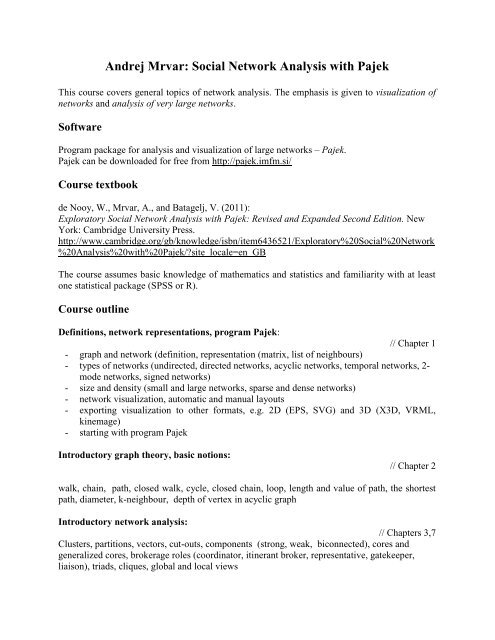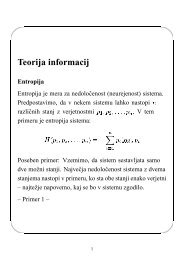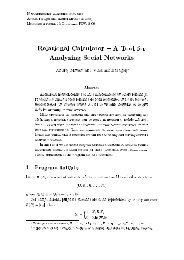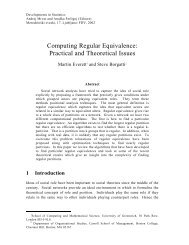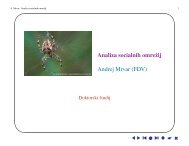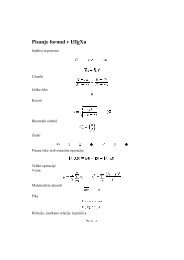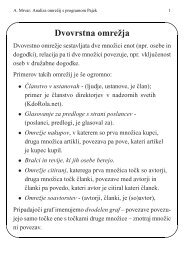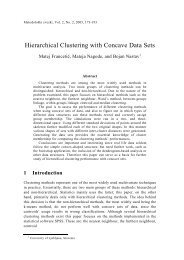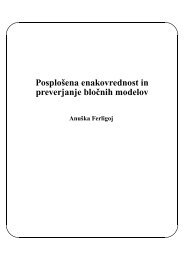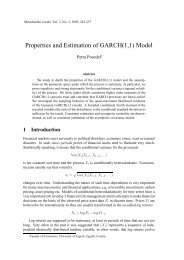Andrej Mrvar: Social Network Analysis with Pajek
Andrej Mrvar: Social Network Analysis with Pajek
Andrej Mrvar: Social Network Analysis with Pajek
- No tags were found...
Create successful ePaper yourself
Turn your PDF publications into a flip-book with our unique Google optimized e-Paper software.
<strong>Andrej</strong> <strong>Mrvar</strong>: <strong>Social</strong> <strong>Network</strong> <strong>Analysis</strong> <strong>with</strong> <strong>Pajek</strong>This course covers general topics of network analysis. The emphasis is given to visualization ofnetworks and analysis of very large networks.SoftwareProgram package for analysis and visualization of large networks – <strong>Pajek</strong>.<strong>Pajek</strong> can be downloaded for free from http://pajek.imfm.si/Course textbookde Nooy, W., <strong>Mrvar</strong>, A., and Batagelj, V. (2011):Exploratory <strong>Social</strong> <strong>Network</strong> <strong>Analysis</strong> <strong>with</strong> <strong>Pajek</strong>: Revised and Expanded Second Edition. NewYork: Cambridge University Press.http://www.cambridge.org/gb/knowledge/isbn/item6436521/Exploratory%20<strong>Social</strong>%20<strong>Network</strong>%20<strong>Analysis</strong>%20<strong>with</strong>%20<strong>Pajek</strong>/?site_locale=en_GBThe course assumes basic knowledge of mathematics and statistics and familiarity <strong>with</strong> at leastone statistical package (SPSS or R).Course outlineDefinitions, network representations, program <strong>Pajek</strong>:// Chapter 1- graph and network (definition, representation (matrix, list of neighbours)- types of networks (undirected, directed networks, acyclic networks, temporal networks, 2-mode networks, signed networks)- size and density (small and large networks, sparse and dense networks)- network visualization, automatic and manual layouts- exporting visualization to other formats, e.g. 2D (EPS, SVG) and 3D (X3D, VRML,kinemage)- starting <strong>with</strong> program <strong>Pajek</strong>Introductory graph theory, basic notions:// Chapter 2walk, chain, path, closed walk, cycle, closed chain, loop, length and value of path, the shortestpath, diameter, k-neighbour, depth of vertex in acyclic graphIntroductory network analysis:// Chapters 3,7Clusters, partitions, vectors, cut-outs, components (strong, weak, biconnected), cores andgeneralized cores, brokerage roles (coordinator, itinerant broker, representative, gatekeeper,liaison), triads, cliques, global and local views
Centrality measures and measures of prestige:- unit centrality measures (degree, closeness, betweenness centrality)- network centralisation- influence domain- proximity prestige- hubs and authorities// Chapters 6, 9<strong>Analysis</strong> of two-mode networks:// Chapter 5- definition of two-mode networks- indirect analysis of two mode networks: transforming two-mode networks to ordinaryvalued networks- normalisations of obtained valued networks- line islands- direct analysis of two mode networks: blockmodelingSigned graphs:- definition of a signed graph- balanced and partitionable signed graphs- inconsistency (error) of given partition of vertices- searching for optimal structural balance partitions using local optimisation- relaxed structural balance// Chapter 4<strong>Analysis</strong> of very large networks, example genealogies:// Chapter 11- programs for entering kinship data- representation of genealogies by graphs (Ore graph, p-graph and bipartite p-graph)- advantages and disadvantages of the presentations- analysis of genealogies (searching for relatives, predecessors, successors, relinkingmarriages)Blockmodeling:- introduction to blockmodeling- equivalences (structural, regular equivalence, other types)- determining blockmodels (indirect and direct approaches)// Chapter 12


